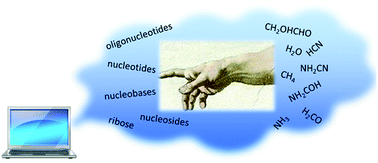Prebiotic synthesis of nucleic acids and their building blocks at the atomic level – merging models and mechanisms from advanced computations and experiments
Abstract
The origin of life on Earth is one of the most fascinating questions of contemporary science. Extensive research in the past decades furnished diverse experimental proposals for the emergence of first informational polymers that could form the basis of the early terrestrial life. Side by side with the experiments, the fast development of modern computational chemistry methods during the last 20 years facilitated the use of in silico modelling tools to complement the experiments. Modern computations can provide unique atomic-level insights into the structural and electronic aspects as well as the energetics of key prebiotic chemical reactions. Many of these insights are not directly obtainable from the experimental techniques and the computations are thus becoming indispensable for proper interpretation of many experiments and for qualified predictions. This review illustrates the synergy between experiment and theory in the origin of life research focusing on the prebiotic synthesis of various nucleic acid building blocks and on the self-assembly of nucleotides leading to the first functional oligonucleotides.

- This article is part of the themed collections: PCCP Perspectives and Prebiotic chemistry and the molecular origins of life


 Please wait while we load your content...
Please wait while we load your content...